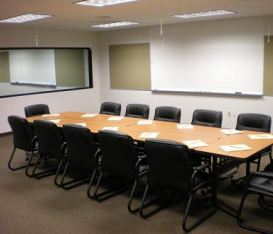
Why a One-Way Mirror Is Not Always the Best Option
In the fields of physics, psychology, and biology, there is a phenomenon called the observer effect, which refers to how observation changes the object or person being observed. For example, taking pictures or videos of a tribal culture that has never experienced such technology introduces new concepts into the society and fundamentally changes their behavior, because this is not a natural experience they would normally encounter during their daily lives.
This is a major concern for user research and focus groups that are conducted in labs with one-way mirrors. When you place people in an environment where they sense they are being observed, their behavior changes. These changes in behavior can drastically affect your ability to accurately understand how your target market feels about your product or service. In our experience, people tend to focus on positive responses and have a very difficult time being completely open and honest about their thoughts and feelings.
One of our primary goals when conducting research is to make participants feel extremely comfortable. One of the ways we do this is by taking a little time to get to know participants and enable them feel that they know us a little, too. To minimize the impacts of observation on research, we emphasize the need for honest feedback and also reassure participants that we are not actively watching or evaluating them; rather, we are evaluating the product and taking notes and listening to their comments to enable us to improve the product. What we have found creates the most anxiety for participants is the idea that hidden strangers are staring at them through a window.
The perfect example is when participants try to complete a series of challenging tasks as part of a usability test. It is easy to see their level of frustration rise as they work through the tasks—while repeatedly glancing at the mirror.
User Feedback on the One-Way Mirror
We’ve had the opportunity to work with thousands of participants, and the feedback we tend to get about one-way mirrors is that they are scary, intimidating, nerve racking, and uncomfortable. In one case, when we asked a participant about the one-way mirror, she responded: “I could just feel everyone watching me, and it made me feel dumb for having such a hard time.” This type of feedback is worrisome because users may not be fully expressing their thoughts about the product. They become distracted by the feeling of being watched when they make mistakes rather than remainingve focused on improving the product by providing thoughtful feedback.
In almost every case, participants were in a very nice room with comfortable couches and chairs, and we had provided them with food and beverages. You might think they would walk away from the experience with a feeling of satisfaction and excitement, considering they had just had the opportunity to get a look at a new product or service. Unfortunately, the mere fact that these people feel like they are being watched changes their overall experience.
We took a deeper look into these anecdotal findings and asked a few research participants more detailed questions about their experience with one-way mirrors, and this is what we found out. Once participants walk into a room and see a one-way mirror, they believe there is a certain way they need to act, a certain way they need to respond to questions; and they feel that they need to do things correctly.
The only way we’ve been able to mitigate these feelings is to talk through them and reassure participants that we’re using the room only so we can tape the session, enabling further review. Since we know, in general, what feelings people tend to have when sitting in a lab with a one-way mirror, we try to address them immediately, as best as we can, and are able to put some of them to rest.

